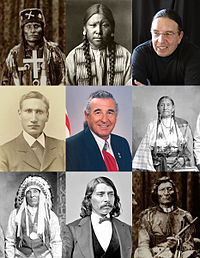Cheyenne are an indigenous people of the Great Plains, who are of the Algonquian language family. The Cheyenne Nation is composed of two tribes, the S?'taeo'o (more commonly spelled as Suhtai or Sutaio) and the Ts?ts?h?st?hese (more commonly spelled as Tsitsistas). These merged to form a unified nation in the early 19th century. Today Cheyenne people are split geographically with the Southern Cheyenne in Oklahoma and the Northern Cheyenne in Montana. The Cheyenne and Arapaho Tribes in Oklahoma and the Northern Cheyenne Tribe of the Northern Cheyenne Indian Reservation in Montana are the two Cheyenne federally recognized tribes. The Cheyenne are believed to have branched off other Algonquian-speaking peoples inhabiting lands around the Great Lakes in present-day Minnesota, perhaps ca. 1500. In historic times they moved west, migrating across the Mississippi River and into North and South Dakota. During the early 19th century, the Cheyenne formed a unified tribe, with more centralized authority through ritual ceremonies and structure than other Plains Indians. Having settled the Black Hills of South Dakota and the Powder River Country of present-day Montana, they introduced the horse culture to Lakota (Sioux) bands about 1730. Allied with the Arapaho, the Cheyenne pushed the Kiowa to the South. In turn, they were pushed west by the more numerous Lakota. In the centuries before European contact, the Cheyenne were, at times, allied with bands of the Lakota and Arapaho. In the 18th century, they migrated west from Lakota warriors, but by the next century, bands of Lakota had followed them into the Black Hills and Powder River Country. By the mid-nineteenth century, they were sometimes allied with other Plains tribes. The Cheyenne are one of the best known of the Plains tribes. The Cheyenne Nation formed into ten bands, spread across the Great Plains, from southern Colorado to the Black Hills in South Dakota. At the same time, they created a centralized structure through ritual ceremonies, such as the Sun Dance. When gathered, the bands leaders met in formal council. Alone among the Plains tribes, they waged war at the tribal level, first against their traditional enemy, the Crow, and later (1856?1879) against United States Army forces. In the mid-19th century, the bands began to split, with some bands choosing to remain near the Black Hills, while others chose to remain near the Platte Rivers of central Colorado. The Northern Cheyenne, known in Cheyenne either as Notameohm?s?hese meaning "Northern Eaters" or simply as Ohm?s?hese meaning "Eaters", live in southeast Montana on the Northern Cheyenne Indian Reservation. In the 2000 census, the reservation had a total population of 4,400, with 72.8%, or about 3,250 people, identifying as Cheyenne. The Northern Cheyenne Tribe reports 9,945 enrolled tribal members as of 2011. The Southern Cheyenne, known in Cheyenne as He?v?hetaneo'o meaning "Roped People", together with the Southern Arapaho, form the federally recognized tribe, the Cheyenne and Arapaho Tribes, situated in western Oklahoma. Their combined population is 12,130, as of 2008. In 2003, about 8,000 of these identified as Cheyenne. With continued intermarriage, it is difficult to separate the tribes administratively.

Related
Algonquian peoples
Arapaho people
Blackfoot Confederacy
Total population
15672



Comment
0